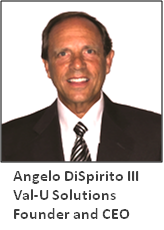News Analysis: HR Summit Offers Front Row Seat to Engagement Challenge
By Bruce Bolger
 Major organizations have begun to look more strategically at engagement, but the process has just begun, based on candid off-the-record meetings with the chief human resources executives of 14 companies at the recent HR Summit, Oct. 26-28 in Denver, produced by London-based GDS International. The one-on-one meetings with HR executives and Angelo DiSpirito III, Founder and Chief Executive Officer of Val-U Solutions, a sponsor of the HR Summit, offered insight into the state of engagement at companies in almost every sector of the U.S. economy. Because all of these meetings were confidential, we can share some general insights we gained from these executives but cannot quote executives directly or name their companies, other than to specify that nearly all were companies with $1 billion in revenues, or close to it.
Major organizations have begun to look more strategically at engagement, but the process has just begun, based on candid off-the-record meetings with the chief human resources executives of 14 companies at the recent HR Summit, Oct. 26-28 in Denver, produced by London-based GDS International. The one-on-one meetings with HR executives and Angelo DiSpirito III, Founder and Chief Executive Officer of Val-U Solutions, a sponsor of the HR Summit, offered insight into the state of engagement at companies in almost every sector of the U.S. economy. Because all of these meetings were confidential, we can share some general insights we gained from these executives but cannot quote executives directly or name their companies, other than to specify that nearly all were companies with $1 billion in revenues, or close to it.

The HR Forum attracted nearly 60 attendees this year, mostly executives who also participate in the HR Forum’s year-round webinars and other opportunities to share information on best practices and key HR issues. The Forum is open to HR executives generally at the level of Vice President or higher, according to Salvatore Papa, Senior VP of the Americas for GDS International. During the 2 ½-day event, sponsors have the opportunity to meet in 40-minute sessions with a pre-selected number of attendees interested in their area of expertise
While we had sessions with only about 20% of the attendees, engagement is a hot topic, based on data provided by GDS in advance of the event. The top areas targeted for investment by these HR attendees in the next 12 to 24 months almost all involve engagement, including (in order of importance) engagement assessment surveys; leadership development; employer branding; employee recognition; benefits and compensation; and analytics.
Here are some other key findings based on the in-depth discussions with HR executives at companies representing almost every major industry sector:
Strategic vs. ad hoc. Even executives at companies where management believes in employee engagement generally say they’re in need of more ROI-based strategies to connect engagement with the brand and organizational objectives. Most executives admit that their engagement efforts tend to be ad hoc rather than strategic, with the result being that employees become numb to them over time. Almost every executive we spoke with admitted that their organizations lacked a formal strategy for engagement, and only a small percentage measure employee engagement on an ongoing basis.
Disaffection with surveys. Those organizations that do use surveys are generally dissatisfied because they note that little is done with the results. Those that do have an action plan say that it usually relates only to leadership and management training/coaching rather than addressing all of the other levers of engagement – communications, learning, innovation, rewards & recognition. etc.
Little confusion between recognition and engagement. While some leading recognition companies were on hand, the executives we met with seemed to have a clear idea of the difference between recognition and engagement – that recognition is one important component of engagement, but only one among many. “One of the recognition companies I met with told me that I could address all of our engagement issues through its recognition platform. That didn’t make sense to me,” one HR exec told us.
A strategic approach. With the exception of an executive from one company with a historic commitment to the concept of engagement, even though the executive said “we never really gave it a name before,” most of the others we spoke to believe their organizations could do a much better job of integrating traditional engagement tools such as management training and coaching, surveys, communications, learning, innovation, rewards & recognition and ROI measurement to align actions with organizational goals.
Timing is everything. Some organizations are undergoing major changes in terms of management and reorganization, while others are just coming out of such periods. For those organizations in crisis mode with significant management changes, it just doesn’t make sense to try to focus on engagement, executives told us. Said one: “We’re in crisis mode but hope to be coming out of it soon, so it’s time to begin thinking about our strategies, but not for action.” Another said: “The timing is perfect for us to now focus on engagement, because we went through a terrible period of downsizing, and all of the people involved with that are gone. We’re a new team, and we’re all committed to achieving our goals through our people.”
Little to no measurement. Most of the organizations we met with had no clear metrics for the outcome of their engagement efforts, and those that did admitted that simply having increased engagement survey scores as a result of their programs wasn’t sufficient as an ROI for justifying ongoing investment in engagement efforts.
The big HR opportunity. The HR executives we spoke with generally believe their teams can play a critical role in helping their organizations support the brand and objectives through employee engagement, but almost all admit they lack a clear framework for doing so. None that we know of were aware that there’s a growing field focused on engagement, with information coming from a wide variety of sources, including the Conference Board’s Engagement Institute, the Enterprise Engagement Alliance’s Enterprise Engagement textbook, and many leading consulting firms.

“The big eye-opener for me was the level of conversation that develops when the subject of engagement comes up,” said DiSpirito of Val-U Solutions. “After 34 years in the recognition business focusing on products, I realized it was time to help clients get to the heart of what makes people contribute to success. When you talk about engagement, all of the issues critical to an organization’s success come up, something that almost never happens when coming to organizations strictly from the standpoint of recognition.”
Val-U Solutions is the new name for 17-year-old Val-U Recognition, reflecting the company’s focus on providing both strategic and tactical engagement solutions, including recognition and branding support. “My firm will play a critical role helping our clients understand how to apply a formal framework necessary to build an engagement program to achieve their goals through people,” DiSpirito explained.
Val-U is an agent of the Engagement Agency, which provides complete support on engagement program design and implementation to a growing number of marketing, management consulting, recognition and other companies seeking to bring engagement solutions to their clients.
In addition to the HR Summit, GDS also produces the CMO (Chief Marketing Officer) Summit.
Contacts for this article:
Angelo DiSpirito III, Founder and CEO
401-322-9250, ext. 101 |
GDS International and HR Summit
Salvatore Papa, Senior Vice President, Americas
786-527-3633


















